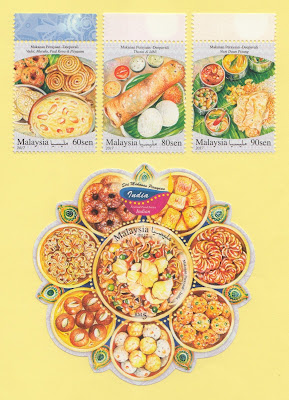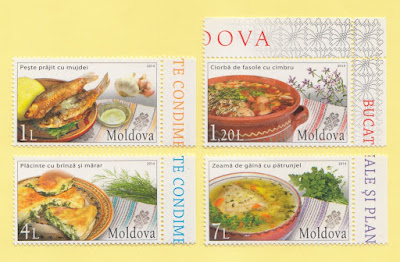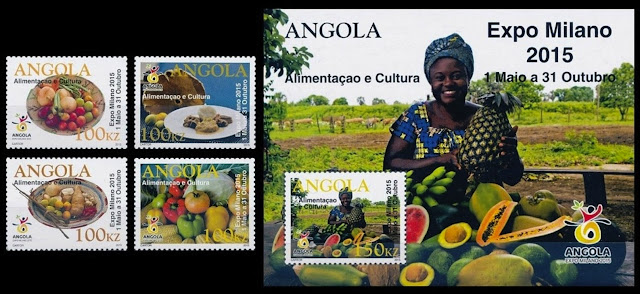Technical Details:
Issue Date: 18 April 2014
Designer: Mihai Vamasescu
Process: Offset
Colours: 4 Colours
Size: 36 x 36, 164 x 92 mm
Values: 1 Leu, 3.60 Lei, 4.50 Lei, 8.10 Lei
About Live healthy! Romanian Traditions
Approaching in the wide range of philatelic themes, an issue of
public interest concerning a balanced nutrition, Romfilatelia develops a new
project dedicated to a healthy lifestyle, by introducing into circulation the
postage stamp issue: Live healthy! Romanian traditions.
Taking into account that there is no food which can assure all
our nutritional needs, it is important, and recommended to have a varied
alimentation including fruits, vegetables, bread, cereals, dairy products, meat
and eggs.
The four stamps of the issue, having the face values of lei
1.00, lei 3.60, lei 4.50 and lei 8.10, illustrate some of the traditional
dishes that can be found on Romanians’ tables on Holidays.
Red eggs, lamb meat, season vegetables, cheese in fir-tree bark
and cozonac cake are among the foods served during the Holy Feast of the
Resurrection of Jesus Christ, being important symbols of the Easter holidays
and embodying Resurrection, purity and the renaissance of the entire Creation.
The red egg has always been associated with the renaissance, the
beginnings, and thereafter with the Resurrection of our Lord. Thus, egg tapping
is accompanied by the Easter greetings: “Christ is Risen!”, “Truly He is
risen!”, that Christians use on Easter time instead of “hello” or its
equivalent. The red colour symbolizes the blood of Christ.
The Lamb is the symbol of innocence, gentleness and purity. The
lamb or the ship embodies the animal to be sacrificed, the Christian as a
member of God’s flock, and Jesus Christ who sacrificed himself for the
salvation of people, overcoming evil. Roasted, baked or cooked in sour soup
with vegetables, lamb meat is a delicious dish. From a nutritional point of
view, rational consumption of lamb is recommended as it is highly rich in
proteins, vitamins and microelements. However, to ensure proper functioning of
the body, lamb roast and eggs should be associated with many salads and season
vegetables, such as wild garlic, garlic, green onion, pilework, and many
others.
The Easter traditional cake called Cozonac, a product similar to
Pasca (a Romanian pastry containing eggs, sour cream and fresh cheese) is
presented as the sweet bread of Resurrection and renaissance of the entire
Creation, replacing thus the pasca or being served together with it.
A symbol of water, life, fertility and wisdom, the fish is one
of the earliest Christian representations, Jesus calling the Apostles fishers
of men, and feeding a large crowd of believers with only two fish and five
loaves of bread. In addition to the union with Christ, the fish is also a
symbol of water, life and spiritual food. Fish products have an excellent
nutritional value. The amount of nutritive elements it contains varies
according to the species and the environment they live in. Fish fats are characterised
especially by the high amounts of Omega 3 polyunsaturated fatty acids.
The cheese in fir-tree bark is a type of dairy prepared in the
mountain areas, being an important source of fat-soluble vitamins (that can be
dissolved in fats or oils), essential amino acids, calcium, phosphorus,
magnesium, selenium and zinc. A balancing element of daily alimentation, dairy
products shouldn’t be missing from any person’s meals. They are delicious,
healthy, and can be combined with many other ingredients.
The philatelic album is created into a limited run printing of
300 pcs. equipped with the block of 4 postage stamps and the First Day Cover of
the issue, having the “first day” postmark clearly imprinted in gold foiling.
Both products are numbered in black from 001 to 300.


















